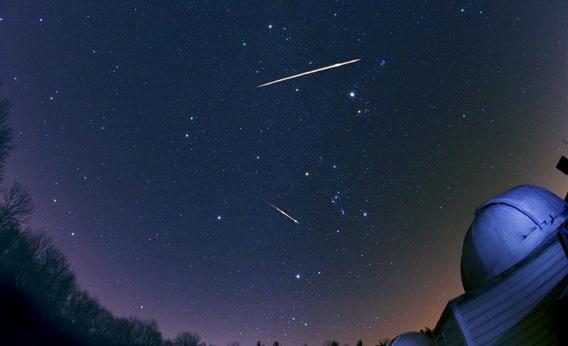Create a free profile to get unlimited access to exclusive videos, sweepstakes, and more!
Geminids Rain Down Shooting Stars

As I wrote a couple of days ago, the annual Geminid meteor shower peaked last night, raining down a magnificent display of shooting stars. Did you go out and watch?
A lot of photographers did. One was John Chumack, an accomplished astrophotographer, who captured this amazing shot of three meteors:
Chumack was in Yellow Springs, Ohio on the evening of the 12th (the day before the peak!) using a simple DSLR camera and a fisheye lens. This was a 25-second exposure, enough to see Orion, Jupiter (the bright âstarâ above Orion), Geminiâthe direction from which the eponymous meteors appear to radiateâSirius, Capella, and a host of other stars.
Chumack says the meteor causing the brightest streak was as bright as Jupiter, and you can see from the photo that it must have flared at least once as it moved across the sky. A second bright meteor traveled down Orionâs side, and third fainter one can be seen just to the left of Betelgeuse, the orange star marking Orionâs right armpit (his right, our left, since the hunter is always depicted as facing us from the sky). Iâm not 100 percent convinced that last one was a Geminid, since the direction appears to be a little off, but itâs possible.
Also out observing that same evening, but a world away, was Colin Legg, who was in eastern Tasmania. To my Northern Hemisphere eyes, his shot is a little more exotic:
Legg was out just after midnight and took this 30-second exposure. The meteor in the shot is almost certainly a Geminid; itâs coming from the right direction. Although it looks like it passed right in front of a bright star, that's an illusion: Like the bright meteor in Chumack's shot, this one appears to have flared brightly for a split second as it burned up as well. That's not a star, that's the meteor itself!
Since Legg was in the Southern Hemisphere, his view is quite different from Chumack's. The Milky Way blazes in the sky in this picture, and you can see the four bright stars in the middle left forming Crux, the Southern Cross, as well as the two bright stars of Alpha and Beta Centauri just below and to the right of Crux. Alpha Cen is the more orange of the two to the lower right; itâs the closest star system to the Sun and was recently found to have a planet orbiting it. To the upper right you can see a fuzzy patch: Thatâs the Small Magellanic Cloud, an irregular galaxy that orbits our Milky Way like the Moon orbits the Earth. Iâve seen the SMC (and its big brother the Large Magellanic Cloud) myself with my unaided eyes when I visited Australia a few years back, and it was incredible. One of the highlights of the trip.
These two gorgeous pictures show you that the meteors are visible anywhere on Earth there are clear skies, and the good news is that the shower should still perform well even after last nightâs peak. If you can, go out tonight and observe it! Iâve written a simple guide showing you how to watch. Itâs pretty easy, not much more than lying down and looking up.
But if you can, try to get some pictures. All you have to do is point a camera up and take a long (30 second or so) exposure. Itâs amazing what you can capture when you do. And even if your photos donât turn out as well as what the pros get, theyâre still yours. As much as I love looking at pictures like the ones Legg and Chumack took, thereâs something even better about having taken them yourself. Give it a try! And if you post them, leave a link in the comments below and let others see, too.


























